Should I Bid on Competitor's Brand Keywords?
Pros and Cons – PLUS: 9 Examples Analyzing the Most Sophisticated Performance Marketers.
The Temptation of Bidding on Another Company’s Brand Terms in Google
Is it wise to bid on a competitor’s brand keywords in Google Ads? For anyone with experience utilizing strategy, it can feel a bit like taking a blow torch to your money when done poorly. But it’s hard to blame anyone for coming to the conclusion that it’s worth at least testing this strategy. You and your team have to hear the question, “How are you different from competitors X and Y?” on sales calls, demos, trade show floors, coffee meetings and email. So why not just bid on those competitors’ brand names in Google Ads? Well, it’s not as easy as it sounds.
Over the last 20 years, we’ve seen competitor keyword bidding in Google Ads most often bomb when executed without a thoughtful plan. Unfortunately, the decision to bid on a competitor is most often not driven by data, but rather, some combination of gut feeling and ego. So why is it so difficult to do well? And how about the outliers that succeed?
Problems with bidding on competitor brand terms in Google Ads
Why is it often risky bidding on competitors’ brand terms? To name a few:
- low-quality scores
- offensively expensive CPCs
- poor conversion rates
Also, it’s challenging to make it financially viable when bidding on these keywords with a traditional measurement model, unless you have a great web analytics team in your corner. For that reason I was interested to look at advertisers who make competitor keyword bidding a cornerstone of their search ads strategy.
Nine examples of successful bidding on competitive brand terms
I assembled nine examples of extremely competitive keyword search spaces and identified the advertisers who either have deep pocketbooks, long-term thinking, clever strategy or a combination of these factors to succeed. You have to hand it to them for deciding to take on these competitors:
- Mailchimp – email & automated marketing
- Pardot – lead generation tool from Salesforce
- Saatva – luxury handcrafted mattresses
- Mailshake – email & automated marketing
- Salesloft – sales engagement software
- Hellosign – electronic signature management
- Blue Apron – meal kit delivery service
- Wantable – curated clothing kits
- Uber – ride sharing serviced the
Note: I have chosen examples that do not contain Granular clients (at least not yet 😀). I have no access to back-end data or insights from them or any of the other advertisers shown to generate these insights.
Example #1: Mailchimp

People search for Mailchimp over 2.2 million times a month globally according to Google Keyword Planner. So it’s logical if you’re a competitor, either head-to-head or have a product that competes on a subset of Mailchimp’s features, that you would try to carve off some of Mailchimp’s traffic.
In the examples shown above, here are some of the tactics used:
- More Features. Lower Prices. – One of the advertisers uses a headline imploring users to “Try Us Instead.” By suggesting they have “More Features. Lower Prices.” it’s essentially telling people interested in Mailchimp you get more for less.
- “Avoid The Spam Folder” – Another advertiser says “avoid the spam folder” in their ad copy. They are hoping to hit on something experienced by a small, but frustrated, group of Mailchimp users that have had issues with their email campaigns going to the spam folder. For some buyers, this hook alone may be strong enough to persuade a user to switch. I’m going to guess these potential customers have horror stories frustrating them to this day when reflecting on prior Mailchimp campaigns.
- The #1 Alternative – One of the other advertisers referenced states they’re the #1 alternative to Mailchimp. Now, how is #1 alternative defined? Are they listed as the top choice on G2.com? A survey? A specific country? Well, as long as it’s true somewhere, it’s fair for this advertiser to reference.
- Clever Wordplay: “Ditch Your Chimp” – The last advertiser I looked at thought it would be clever to use a headline that hopes to draw the attention of the user: “Ditch Your Chimp.” Personally, I think this approach has potential but is likely to result in getting shut down. It is close enough to Mailchimp’s name that their team can successfully make the case it’s their trademark (note: here’s the official link from Google to submit formal trademark complaints). Ultimately, users may click through the ad at a higher rate, but what else can you do on the landing page to keep them?
Example #2: Pardot
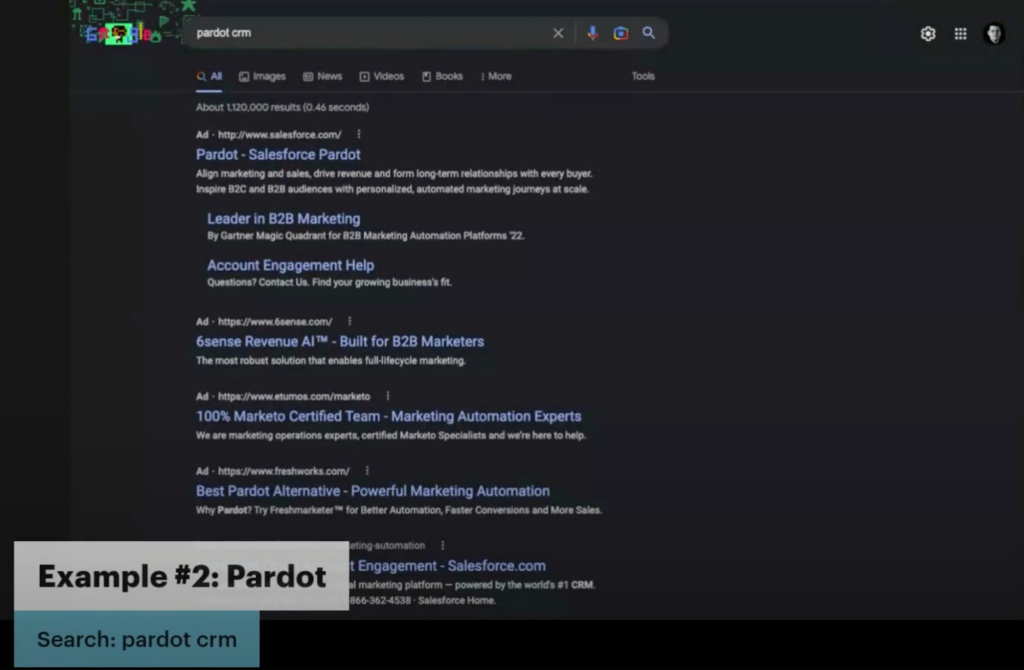
Google’s timely acquisition of Pardot, a leading marketing automation platform, was a successful strategic move. Even though Salesforce wants their users to refer to it as Salesforce Marketing Cloud, customers old and new still refer to it as Pardot. So it’s logical that competitors would try and bid on that brand.
Here is one particular example I found when looking at the keyword search “pardot crm”:
- “Best Pardot Alternative” – Bidding on a competitor’s brand terms is one thing. But using their actual trademarked term in the headline is just playing with fire. Using the keyword in the headline will certainly result in a higher click through rate (CTR). But it will get shut down unless there is an agreed-upon deal in this example.
Example #3: Saatva
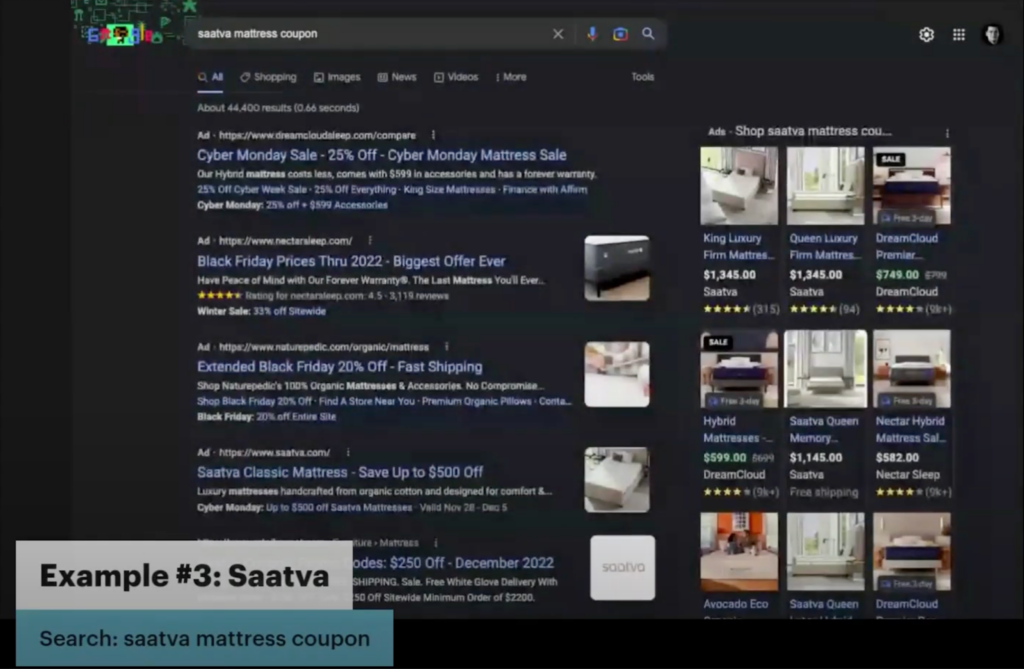
Saatva is searched at least 49,500 times a month globally according to Google Keyword Planner. The “mattress-in-a-box” space exploded years ago with Casper and Leesa having the first mover + biggest war chest advantage. Soon after, brands such as Purple, Tuft & Needle, and the example referenced here, Saatva, came on strong.
This vertical is extremely cutthroat and requires either developing a brand, strong positioning to specific audiences or some other clever distribution strategy (sold in Target, sold in Mattress Firm, retail presence) to succeed. Oh, and a lot of money.
Here are a few examples of what some advertisers are doing to compete on the search “saatva mattress coupon”:
- “Our mattress is $600 less.” – Sometimes, it does come down to price. And one advertiser in this example plays the best card they have.
- “Black Friday Prices run through 2022.” – Kohl’s pioneered the idea of deals and discounts all year-round. So why shouldn’t this advertiser borrow from the strategy of extending Black Friday prices throughout the holiday season? While yes, it’s true, consumers have started to become suspicious of the “deals” they’re getting around the holiday, I think this is actually pretty clever. This establishes a new anchor for a user for what they should expect for how long a deal should run.
The last advertiser referenced does something above and beyond to build a successful competitor bidding strategy, but not with their search ad copy. Instead, they built an expertly-crafted landing page optimized to persuade users looking for Saatva to convert to them. Here are a couple screenshots of the landing page:
Features Comparison Chart: Us vs Them

Who doesn’t love a good comparison chart, where you get to figure out how to choose the features that give you all the green check marks and your competitor the red Xs? Well, this wouldn’t be used if it wasn’t effective – and this advertiser executes perfectly. They even throw a little Santa cap on the top of their column. Hats off to them.
Real Customers Switch to Us. Here’s Proof!

What’s better than having custom testimonials? How about customer testimonials from users who specifically call out why they prefer your brand to Saatva. Even better if you can address your potential buyers’ suspicions with specific reviews from verified buyers.
Example #4: Mailshake
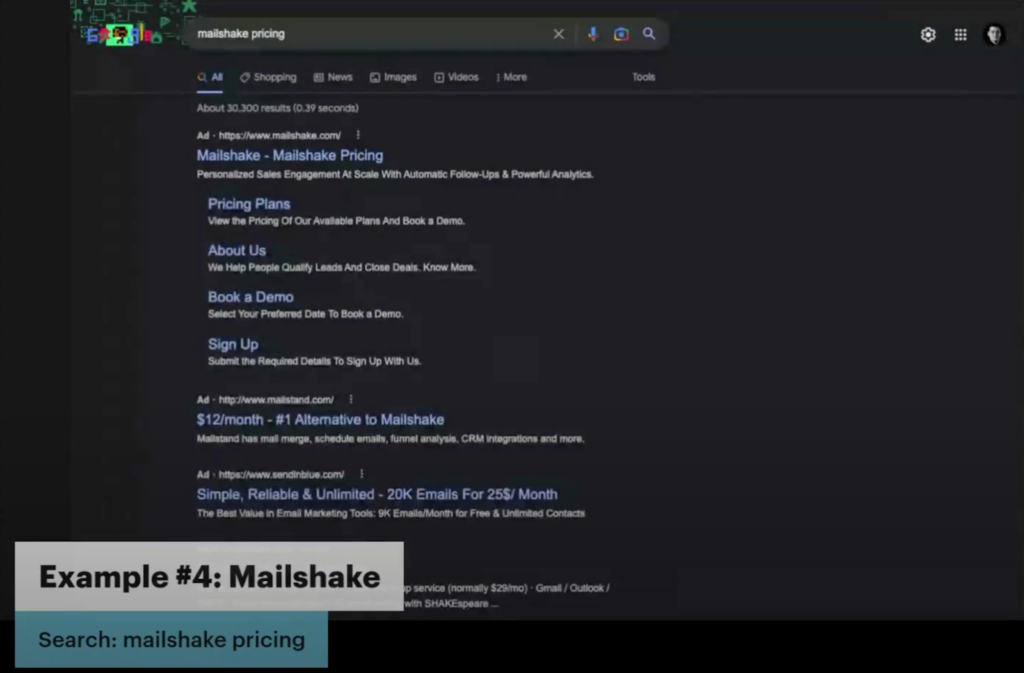
Mailshake is one of the most popular, lightweight sales engagement platforms around. They have a 4.7 / 5 rating on G2.com with over 220 reviews. It’s because of their competitive pricing, great user experience and integration with other platforms that their competitors would aim to bid on their brand terms.
Here are a few examples of what some advertisers are doing to compete on the search “mailshake pricing”:
- Cheaper and The #1 Alternative? – One advertiser is calling out pricing right in the headline: $12 per month. I would have to assume Mailshake is more expensive than this, which is why this advertiser so confidently calls out their pricing. This might not be the “whole truth,” but is it technically true enough to feel confident running this copy in the headline? I’m guessing yes. Similar to a previous example I listed, being the #1 alternative is easy to say for just about anyone.
- Unlimited Emails? – Another advertiser calls out the ability to send unlimited emails. Perhaps Mailshake has a cap on the number of emails one can send. Who knows. But if this is a frustration from power users of sales enablement email platforms, then this could be a compelling enough differentiator.
Example #5: Salesloft
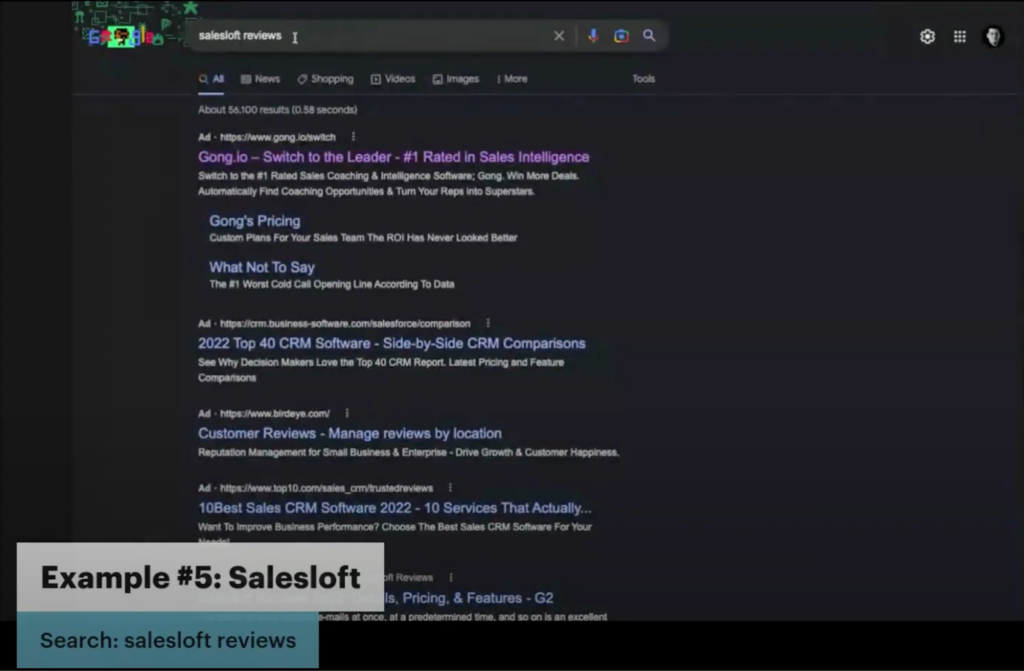
In 2022, Salesloft was acquired at a valuation of $2.3 billion. This one-time startup quickly rose to front-runner status in the sales enablement space. With over 49,500 searches performed each month on Google globally according to Google Keyword Planner, competitors stand to gain a lot if they can make a competitor bidding strategy work on Salesloft keywords.
I took a look at what examples showed up for the search “Salesloft reviews”. One particular advertiser stood out. Here’s what I found when looking at their ad copy and landing page:
- Leads with Their Brand First. Then Says “Switch to the Leader” – This advertiser does not try to trick users into thinking they’re Salesloft. Instead, they lead with their brand in the headline. Then, they use an active voice versus a passive tone to speak to the user: Switch to the Leader.
Here’s a screenshot from this advertiser’s landing page that helps reinforce these claims:

They reference other well-respected brands and key stats from case studies to show measurable improvements in their sales process. The most well known of these brands being LinkedIn, which they place into its own testimonial block quote.
Example #6: Hellosign
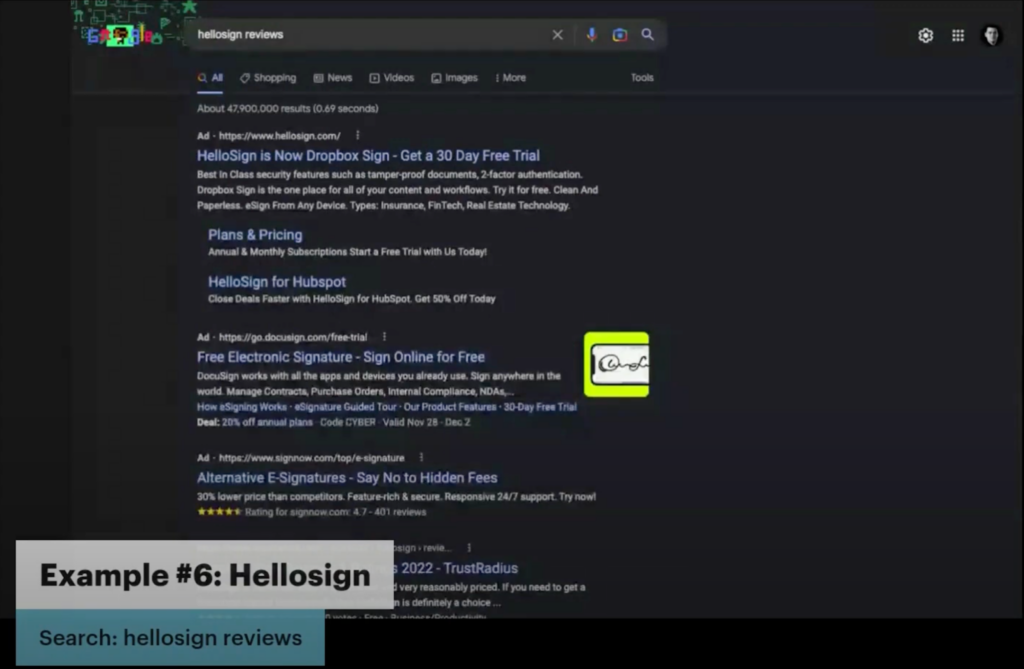
Hellosign (now Dropbox Sign) is a leading eSignature platform used by every type of organization you can imagine across the globe.
I wanted to take a look at what competitor’s were doing when users performed the search “hellosign reviews”. Take a look:
- “Works With All Apps and Devices You Already Use” – This advertiser understands that users are creatures of habit. And one of their big advantages as the 800-pound gorilla in the eSignature space is the ability to develop for edge case platforms. It’s smart to call this out in the ad along with matching the 30-Day Free Trial that Hellosign offers.
- “Say No to Hidden Fees…30% lower price than Competitors” – For certain users, getting a product that does the job for less money is all they care about. This coupled with the review extension featuring over 400 reviews with a 4.7 star rating is not bad at all.
Example #7: Blue Apron
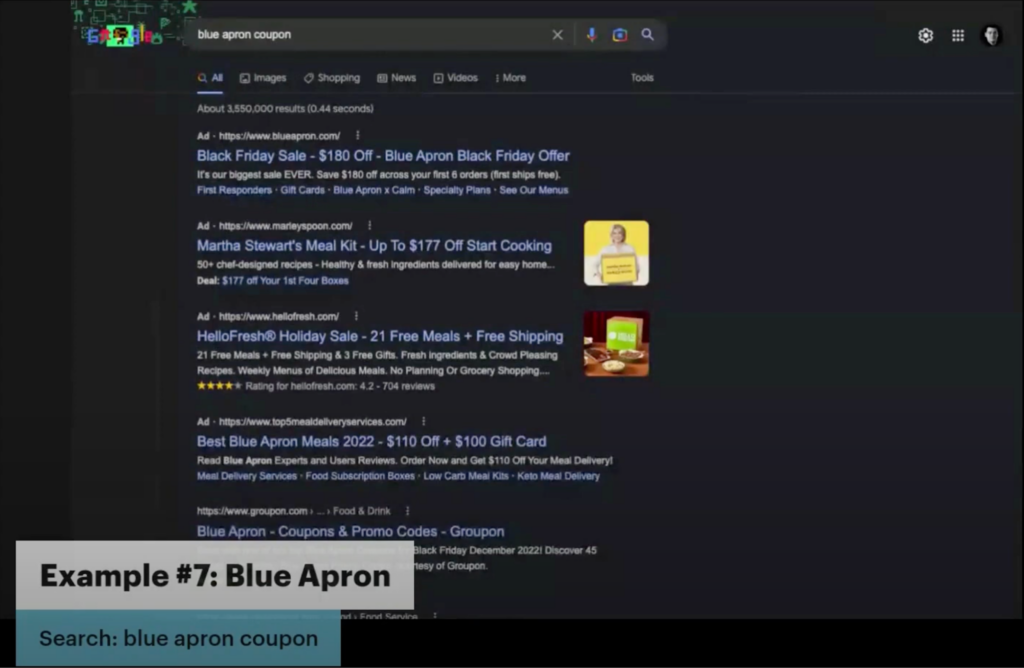
Blue Apron is a meal-in-a-box-delivered-to-your-door subscription company that helped popularize this vertical. You can find their ads pretty much anywhere on the internet, on TV and even in those Valpak envelopes I sometimes open out of curiosity.
Clearly, the advertising coupled with their service pays off, because over 201,000 people search for their brand name every month according to Google’s Keyword Planner.
There are two advertiser examples I found that used great ad copy to try and persuade users searching for “blue apron coupon” to give them a try instead:
- Martha Stewart + Up to $177 off – When you can’t use the competitor’s brand term in your ad, you play your best card. And for this advertiser, they use Martha Stewart’s name in the headline and her picture as an Image extension.
- 21 Free Meals + Free Shipping – This advertiser leads with all the goodies: 21 free meals, free shipping, AND 3 free gifts. Their goal is to pack so much value that a user feels compelled to at least click through the ad to see if there are exceptions to this great offer.
Example #8: Wantable

Wantable is one of the leading clothing subscription services in the World. Oh, and by the way, they’re based here in my favorite city in the world: Milwaukee, Wisconsin. With a 4.7 star rating and over 60 reviews on Trustpilot, I can understand why competitors would want to figure out a strategy for grabbing users searching for them.
Two examples stood out when I did a search for “wantable reviews”:
- “Get 30% off our 8 Item Plan” – One advertiser offers what appears to be a sizable discount with 30% off. But a closer inspection shows it applies to an 8 item plan. And does membership mean committing to something longer than month-to-month…?
- “For Women 5’ 4” and Under, #1 Subscription for Short Gals.” – This is probably my favorite example so far of an advertiser straight-up speaking to a specific subset of a broader audience. This competitor does not try to use Wantable’s name in the ad. Instead, they make it clear to the user doing this search that, if you’re 5 ft 4 inches and under, they’re the solution. If you fall into that category and you see this ad, I have to imagine you would click on it. I bet the data supports this as well.
Example #9: Uber
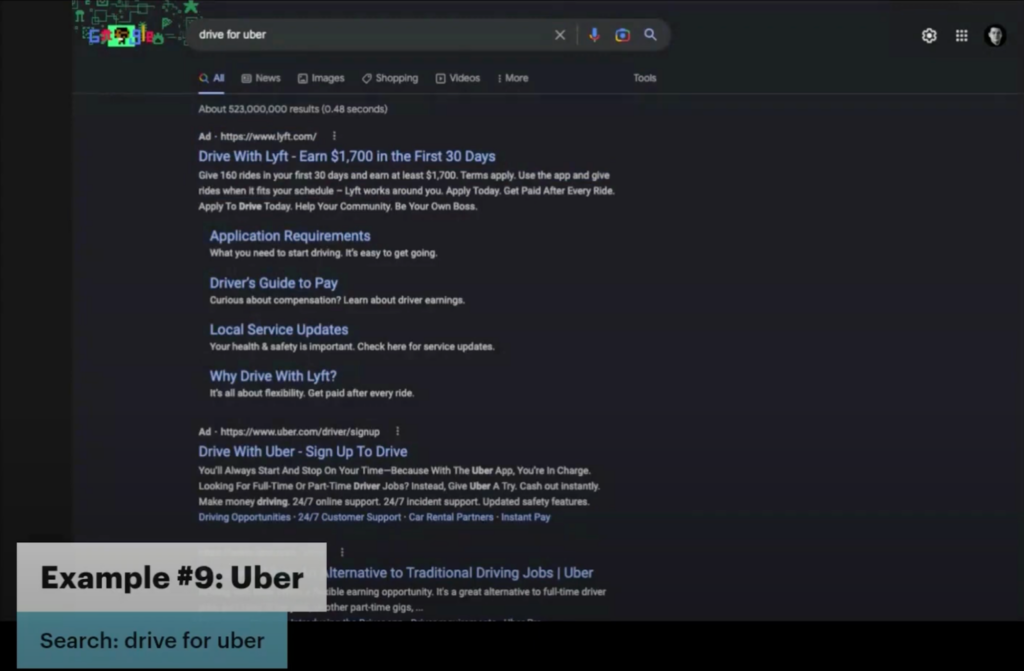
Uber is the #1 ride hailing company in the United States.
For this reason, I was curious what their #1 competitor did when I searched “drive for uber”:
- Earn $1700 in the First 30 Days. Get Paid After Every Ride – They lead with numbers and refer to payouts after each ride.
I also looked at their landing page. Here’s a screengrab of their simple, but effective, approach:
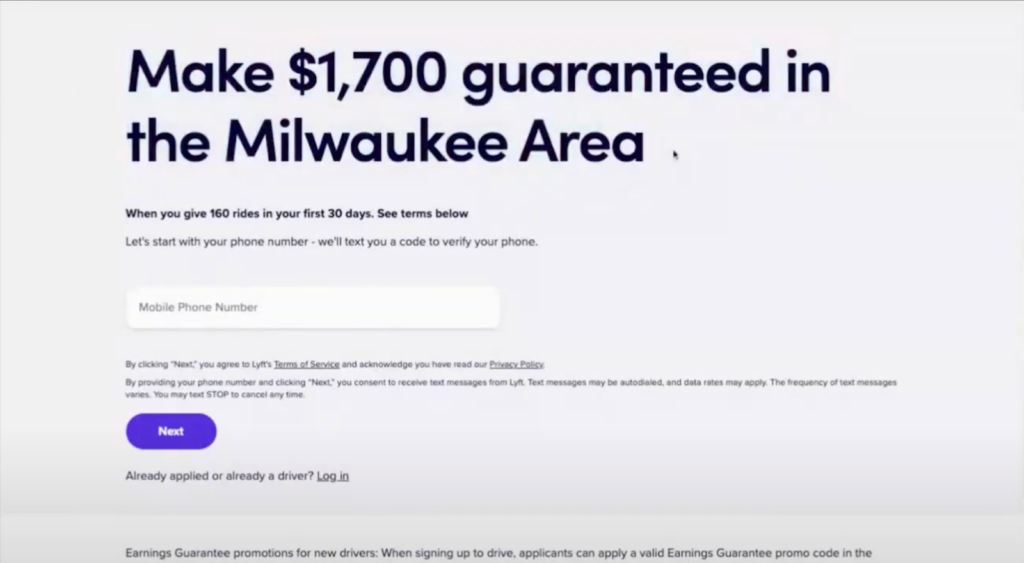
This advertiser repeats the call-to-action from the headline: Make $1,700 guaranteed when you give 160 rides in the first 30 days. This is great cohesion between ad and landing page. They even take it a step further by detecting the location of my device to insert my location..
Lastly, the information they ask for is minimal, just the phone number and a click of the purple “Next” button. I dig it.
Ways to Approach Bidding on Competitors’ Brand Terms
1) Highlight Your Benefits
Own the characteristics about your company or organization that are unique differentiators.
- Pro: You don’t run the risk of getting ad shut down due to trademarked terms.
- Con: Clicks are likely to be expensive because ad relevance will likely be low due to lower click-through rate.
- Con: It might be difficult to get repeatable and sustainable traffic from these terms.
- Con: Without a dedicated landing page strategy and offer, it will be hard to have an economically viable path to profiting from the ad spend..
2) Reference The Competitor Brand Indirectly
- Pro: Can draw attention and potentially increase click through rate
- Pro: as long as the term is not an owned trademark, likely OK to use in the ad
- Con: is the juice worth the squeeze to get clever with the ad?
3) Reference the Brand Directly
- Pro: short term, higher click through rate
- Con: ad is likely to only be approved limited automatically due to not owning the trademark OR having permission to use it (https://support.google.com/adspolicy/answer/6118)
- Con: owner of the trademarked term can force ad to be shut down
The Cases For Bidding on Competitor’s Brand Terms
- Contrast Marketing: When there is a well-established leader or leaders, if you have a distinguishing benefit to position yourself against them, you can get meaningful traffic and conversions.
- You’re Well Prepared: If you have a cohesive strategy, really understand your budget, bid strategy, ad copy, landing page and conversion path, it can make sense.
- Competitive Research: If you want to get more granular information about search volume for competitors, along with other advertisers competing for the same terms (auction insights report), it’s really the only way to understand this.
The Cases Against Bidding on Competitor’s Brand Terms
- Return on Investment: It can be difficult to make the economics work. Higher click costs and difficulty in getting impression share means volume is limited. Also, you are likely to experience lower conversion rates without a dedicated landing page strategy.
- Unwanted Exposure: The best case is the gamesmanship may slightly annoy your competitors. The worst case is it puts you on their radar and they decide to make your life difficult (expensive, legal threats, etc.).
- Cost of Your Time and Resources: It takes time and energy away from building your own brand, taking time and money away from top or mid-funnel strategies. Over time, real brand building is the highest ROI investment of time and resources, even if in the short term it can be frustrating.
Closing Thoughts
If you are looking to explore bidding on competitor’s brand terms as part of your search ads strategy, take into consideration the factors I mentioned. Hopefully, the examples I shared are helpful in generating ideas for how to approach bidding on competing brands.
